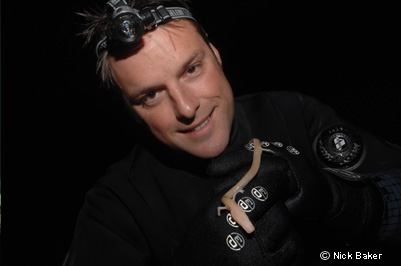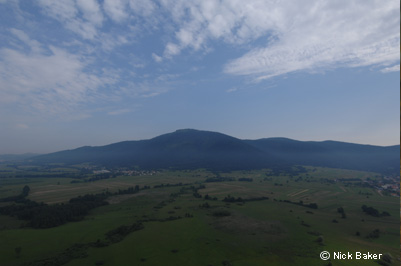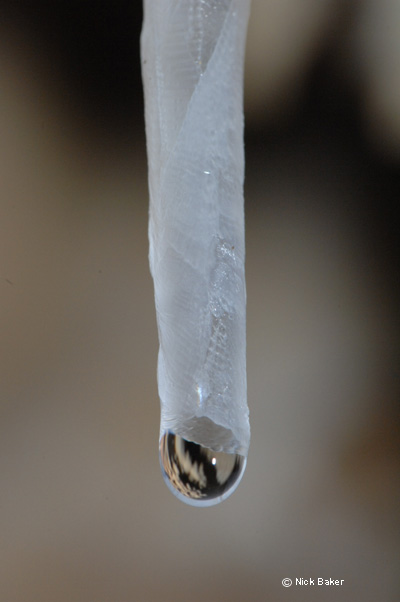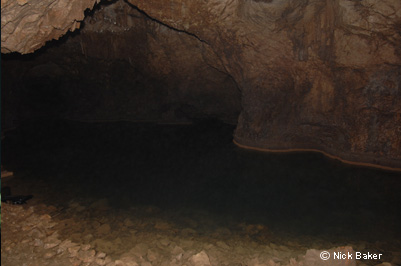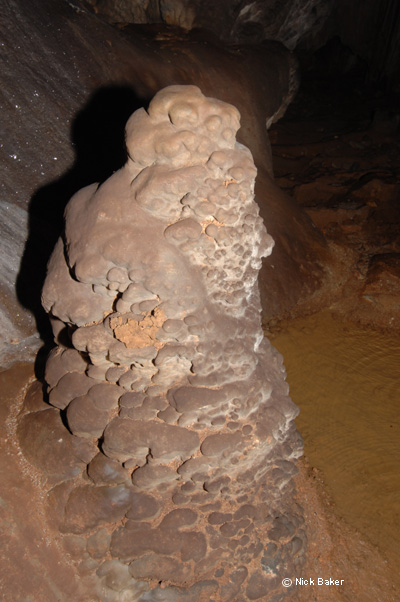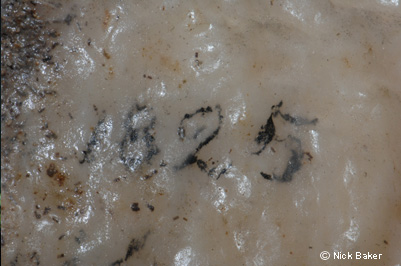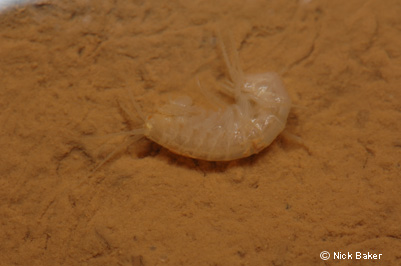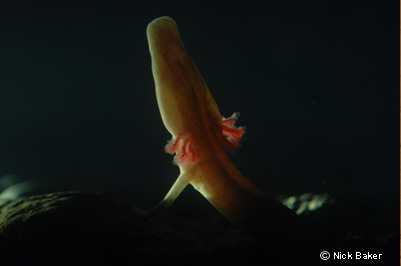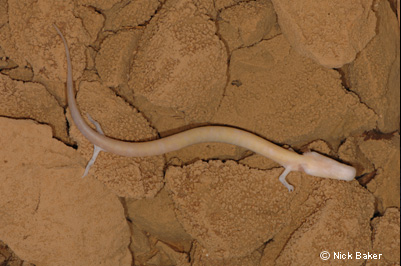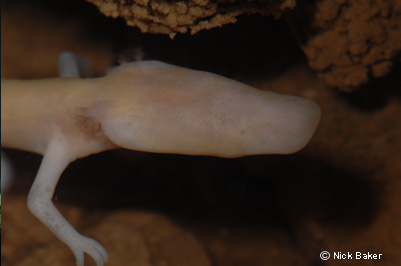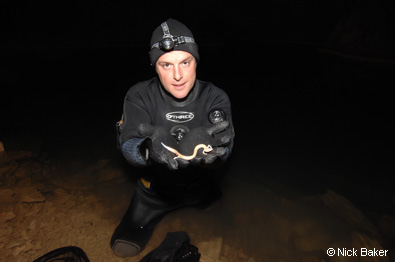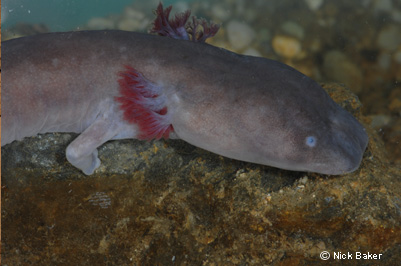After a life time of waiting for the opportunity it finally came last year. I got to meet one of the most bizarre and highly unique amphibian oddities that this world has to offer. What made this experience even more exiting was the extreme environment in which this creature dwells and the adventure that seemed to go hand in hand with actually seeing it.
If I think about it, I’ve spent more time than I care to admit ‘newting’ or ‘frogging’ in ponds, ditches, streams and rivers the world over, but the last few years while filming ‘Nick Baker’s Weird Creatures’ I’ve had the chance to pursue some highly specialised amphibians and this has meant upping the stakes a little and in doing so I’ve had to engage in some fairly extreme ‘herping’ while in pursuit of animals that I feel rather unfairly have missed out on the limelight usually on account of them being just a little bit ugly.
Normally this pursuit involves nothing more specialised than a net, bucket and maybe a pair of Wellingtons. But last summer found me packing torches, infra-red cameras and lights, a hard hat, as well as a serious selection of thermals and a dry suit.
I was going underground to meet that stringy and rather pallid slither of amphibious life called the Olm, its domain, the complex Karst cave systems of Slovenia.
My first sighting came during a rather bizarre and dubious experiment into human physiology. I had agreed to spend my first 24hours in the caves, not only totally on my tod but also without any artificial light source except a tiny red LED head torch, which unbeknown to me at the time was half its usual brightness because the batteries were going flat.
The original idea was to see what kinds of physiological effects total darkness would have on a human and in some way relate it to what has happened over time to the Olm. And if nothing really came of this then it had another and to me more solid purpose, and that was getting a truly intimate perspective on this animals life here in the aphotic core of a limestone mountain and in doing so gain a better understanding for the challenges that life has to meet for a truly cavernicolous existence here in the underworld.
After the crew left me and I had raided my thermos and supplies I had been trying to get some sleep at my self proclaimed base camp. But I’ll be honest with you the incessant dripping of a hundred million stalactites as they each grew infinitesimally longer put pay to that.
Some dripped fast like an expensive watch mechanism, high pitched and purring; others announced themselves with big positive dollops of moisture beating a regular rhythm; while some, like the one that kept dripping on my face from a stalactite some 20 metres above me didn’t seem to have any regularity to them at all.
On top of this in the dark ones mind plays games on itself and I started hearing things, the of banging doors and peoples voices plus every now and then a strange sighing – which sounded for all the world like the mountain was breathing (on mentioning this to a cave guide the next day I was told that this was the caves speaking to me).
So, being a stereotypical bloke and not one prepared to admit he was scared of the dark I decided to distract myself and give myself something to do. Even though I knew the film crew would be back the next day and we would film the Olm with proper lights I decided to try and get the first sighting not only myself, but by myself, which is how I found myself stumbling through the reverberating chambers of Postojna cave.
My base camp was already some 4km from the cave entrance and despite the fact that it is a very popular tourist cave I was well off the beaten track, it felt very unnatural and definitely quite eerie to be crawling further and further from my own species and deeper into an under world that we have only really just began to explore.
The caves themselves are vast; over 12 miles of cave system have been revealed here since around 1818 when the caves had started to be properly explored and it contains caverns big enough to contain cathedrals right down to the tiniest crevices that you would have to lie prostate to get through.
All this created by the busy Pivka River which dives underground close by and has spent the past millennia permeating, penetrating and dissolving its way through the cracks and fissures within the limestone.
It’s an environment where it seems rock is turned to liquid; the shadows and silhouettes of the rock formations and carvings are fluid in their appearance and seem to being paying tribute to the element that created and continues to create them to this day. For the visitor it’s like being inside a giant and overly ornate wedding cake.
The only problem is I couldn’t see any of this at the time; my vision had been inadequately replaced by the pathetic green glow given off by the 2 inch LCD screen of my tiny camera. Using this technology I tried to navigate my way along a narrow path with varying degrees of success. I guess I succeeded in the fact that I avoided killing or maiming myself by falling down any of the several drop offs where the path seemed to crumbled away into a black void, but failed in the sense that I was forever banging my head, walking into walls or cracking my shin on the any one of the thousands of stalagmites that rose from the floor like giant stone skittles.
The sound of water is everywhere reminding the visitor to this subterranean world that caves like this are very dynamic and still very much in the process of being created, in places the caves narrow and a rush of cold air hits you, belying the presence of hidden connections to the upper world. There is trickling and of course the ever present dripping. As I disappeared further into the depths, small still pools of water reflected weakly in the light of my screen and if I was to pour over them with my head torch I could sometimes make out the pasty forms of living things.
At first this comes as a real surprise to the naturalist; that life can find away even down here in the stygian depths, small blind things, ghostly pale like spirit versions of their brethren from above poke and prod their way through the silts, scavenging for any form of sustenance mislaid by the surface world.
The closer I get to one of the Pivkas fluid fingers that come rudely rushing out of one chamber wall and vanishing off into another, the more life is seen.
Here is a real energy link to my world; the water washes down with it not only decaying plant life, host to all the detritivores such as the cave freshwater shrimp, Hog-lice, true shrimps and flatworms but these also in turn feed larger creatures.
When I say large here it’s all relative; there are fish in these pools not true Troglobites but species from the surface world that have been flushed down here and manage to survive on wash-me-downs.
Small Gudgeon and Minnows dance in the weak incandescence of my cameras glow below the surface and the rather tragic almost sacrificial spectacle of an adult Dragonfly. Newly emerged from a nymph borne down the river it sits expectantly awaiting a sun that will never come, and warmth that it will never dance. Poised like a jewelled crucifix on top of a twig, it will eventually fall from its perch and dissolve into the organic sludge; a death to provide life for the other scavengers. This chain of nutrients ultimately fuels the life of 84 different species here in the Slovenian caves, some obligate Troglobites others part timers and wash-ins.
But its this life that makes possible the existence of the worlds largest cave vertebrate, an animal that has mastered the dark and the reason that I find myself in such an uncomfortable situation right now.
I can tell I’ve entered a bigger cavern but the change in acoustics; the reverberations of my footfalls don’t seem so lonely. The echoes make me feel a little spooked so I start to sing to myself, for some reason the ‘frog chorus’ seems appropriate reminding me of a warm and fuzzy world that I have temporarily left behind. Unlike the Olm I can return to the sunlight and survive.
The path now sticks to the left hand wall of the cavern, winding and hugging the stone relief like a mountain road, it falls away sharply to the right, its a short slope, not quite a shore, made up of lots of sharp bits of broken speleotherm; shards of stalactite and stalagmite are recognisable among the debris. This slope continues on for 4 or 5 metres into the depths of a pool so crystal clear, I at first accidentally dip the camera lens into it, not being able to see where air ends and water begins.
I spent a good twenty minutes slowly clambering along the shore of this sub terrestrial pond. The feelings were indescribable; part of me was on terrified of being here, the moaning sound of the river somewhere further on kept changing, sounding like voices which freaked me out, especially knowing for a fact there was nobody near. Then the occasional breaths taken by the caves put me right on edge, without my sense of vision this monkey was wrestling to squeeze some sense out his remaining faculties and failing.
I truly wanted to run back the way I came, only running out was not an option, even walking was impossible, I would still have to travel a good 2km further just to get to the main tourist area, it was probably out of hours which meant I would have to use one of the emergency phones to call someone to come the 4km from the cave entrance to the pick up point and it may well be the middle of the night there was no way of telling (the producer had deliberately removed my watch). So I had no real option than to try and connect with the inner ‘pond dipping’ child that had always dreamed of this moment, the chance to find a real live Olm, in situ.
Then after I had caused a mini rock slide with my clumsiness I see a pallid form move, ever so slightly just a few centimetres below the surface and close enough to touch. At first it’s just a snout, looking much like dead flesh, more like disembodied human finger tip, which immediately seemed to take offence to my accompanying glow, an experience that to a creature that had almost certainly never seen light in 60 years or more, would have seemed as rude as a flashlight in the face.
I of course automatically use the word ‘see’ here but of course this is probably not really true in the sense of the word. Looking at the strange ‘moomin like’ head peering (there I go again with references of vision) out from the rocks I can just make out two grainy patches of pigment on the animals head. These are where its eyes should be, but weirdly for an animal that is an obligate cave dweller, they are not totally useless, in fact these redundant eyes are along with many other parts of the animas body, photosensitive. Yet another curiosity of this animal is that if they are taken to the surface and kept in the light they not only darken (they still retain the ability to produce melanin) but the cells of the eye patch migrate towards the skins surface and the animal develops simple eyes again (although how good they really are remains the topic of debate).
My first Olm was certainly being very photosensitive and with a slow and deliberate effort it, centimetre by centimetre pulled its body out from hiding.
I was truly knocked out by how long they really are, like those who know what I’m talking about it looked like a pale extruded version of its closest relative on earth – the mud puppy from the USA.
First the end of the head was announced by a tuft of fluffy gills on either side, my imagination filled in the colours as I had seen pictures of these animals before and had kept albino axolotls, but nothing quite prepares you for the satiny grace of their movement, as they gently pulsed with each forward movement made by their owner in the water. Next up the equally spindly front limbs, complete with three blunt rounded toes, gently treading on the silt covered rocks, leaving tiny hieroglyphics in the fine sediment, the whole effect looking for all the world like this creature was walking in moon dust.
Then it seemed to take for ever for the rear legs to appear, With an adult animal measuring somewhere in the region of 30cm from tip to tip, there is an inordinately long stretch of body between the front and rear limbs of an Olm, and when they finally appear they are like little blanched crotchets with only two toes.
Then by the time the tip of the tail had left the hiding place the head was beginning to reach the edge of the range of my infra-red camera and the sallow Olm slid back into the darkness it was so much happier in.
I was reminded at this point of a quote I had heard that
“The Olm has traded extinction with another form of oblivion” a reference to the moment when the precursors to these unique amphibians were originally flushed down into this seemingly inhospitable environment.
The whole experience lasted only a few moments but they are seconds that I will never ever forget. I had finally met the Olm also known as the White Mocheril or Human fish.
This however is only a small part of my story. We did film here in this very pool some 18 hours later and despite the small size of the water body, a surreal snorkel in the water revealed 50 or so Olm’s living their slow motion lives below the surface, most the size of the adult I had already seen but some tiny ones too looking like tiny white threads of cotton, impossibly delicate among the large and sharp rubble they lived in.
Once exposed to my light they quickly retreated into crevices the only signs they were there being a tail or head peaking out here and there. But no matter how hard I searched I couldn’t seen any other signs of life in this particular pool, not like those that were plumbed in to the main flow directly. Why? Had the Olm’s eaten everything? Hunted every last invertebrate down with their highly developed sense of smell and electroreceptors?
I guess this is all part of the mystery; some say this animal can live for 9 years or more without ingesting anything but its own sloughed skin. It certainly has an interesting metabolic trick which allows it to be incredibly economic with its energy bill.
Perhaps these animals wait for floods that cause the rivers to go into spate and flush new life into these pools or even move the Olm’s onto more productive pools, being passed around the honey-combed world at the whim of the waters – who knows. Seeing this animal conjures up all manner of questions and makes the imagination run riot as to exactly how they live their lives down here and you can just imagine how the first Olm’s washed out from the cave systems into our world were thought to be embryonic dragons spewed forth from some mysterious underground lair.
The story of the almost apparitional Olm is even more peculiar than all of this. Suffice to say in the black depths lives the White Olm and in the lit environs of the surface in the white Karst region of the country lives a sub-species even rarer and more mysterious than its white cousin it of course is the Black Olm.
‘What’s Black without white and what’s Dark without light”
But that dear bloggers is another story!
